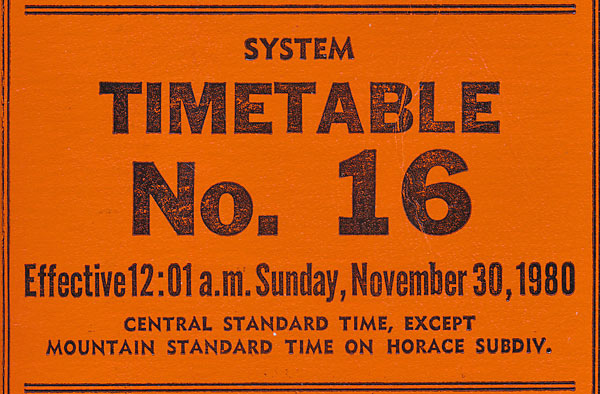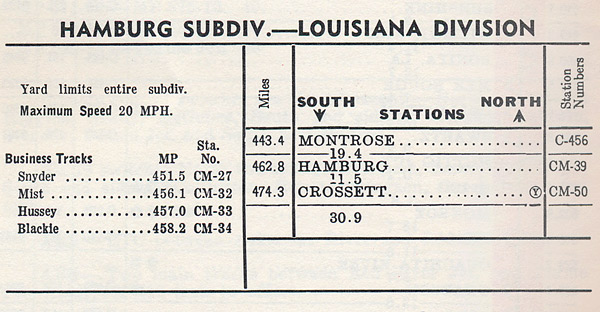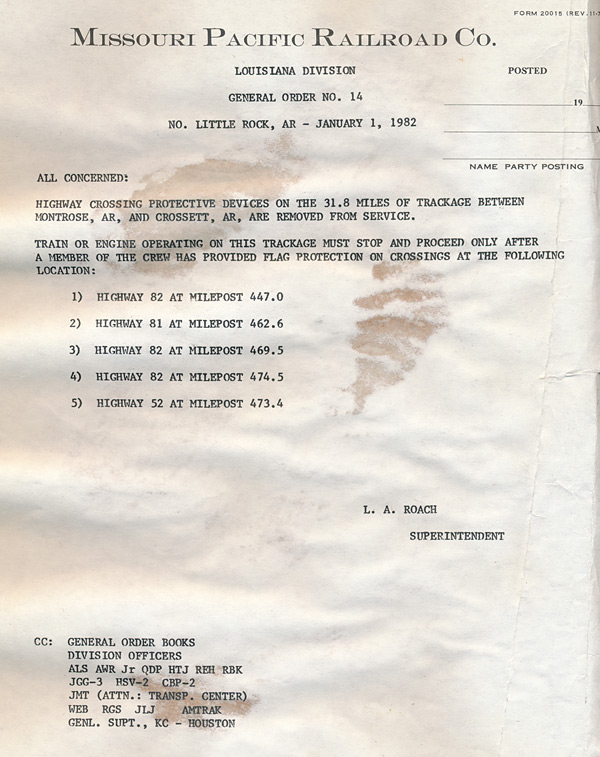Mississippi River, Hamburg & Western Railway
© 2012 by Bill Pollard
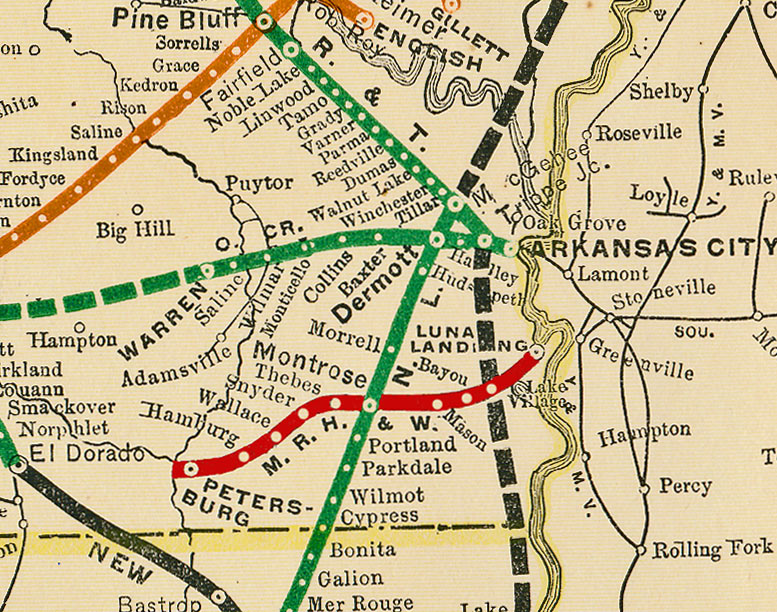

The Mississippi River, Hamburg & Western was incorporated under the general railroad laws of Arkansas and articles of association were filed with the Secretary of State in June 1897. Missouri Pacific's 1915 corporate history gives a date of June 3, but the 1899 Arkansas Railroad Commission report lists June 18 as the date of filing. The MRH&W was incorporated by outside parties (i.e.-individuals not associated with MP-Iron Mountain), with primary officers located in New York and Colorado Springs. A primary goal seems to have been to provide rail access to the Mississippi River at Luna Landing. Construction of the railroad may have been aided by land grant legislation passed by the Arkansas General Assembly in 1897. On this 1901 map, the MRH&W is shown as completed to Petersburg (southwest of Crossett) but in actuality, the trackage west of Hamburg was still under construction. The Iron Mountain's north-south line through Lake Village would not be completed until mid-1903, four years after the MRH&W arrived in town.
The first annual report of the Arkansas Railroad Commission (1899-1900) provides some description of the railroad as of that date, and the identity of the original officers and promoters of the line.
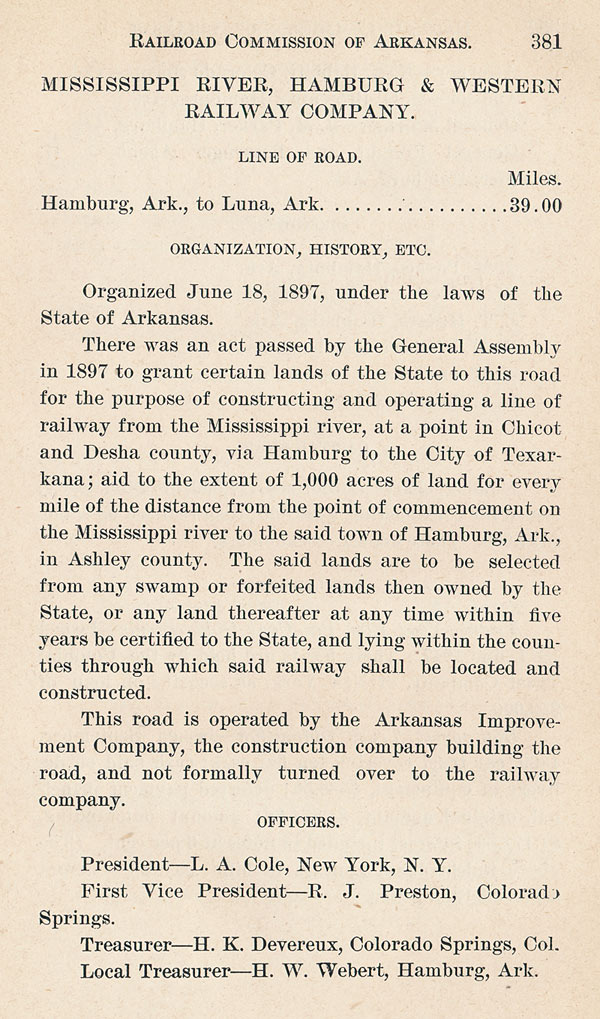
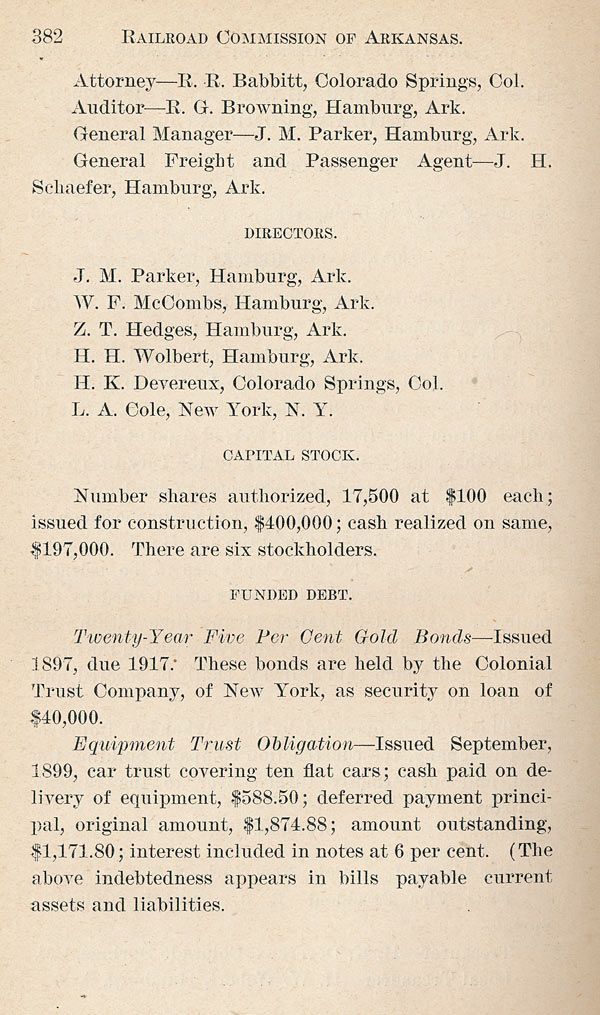
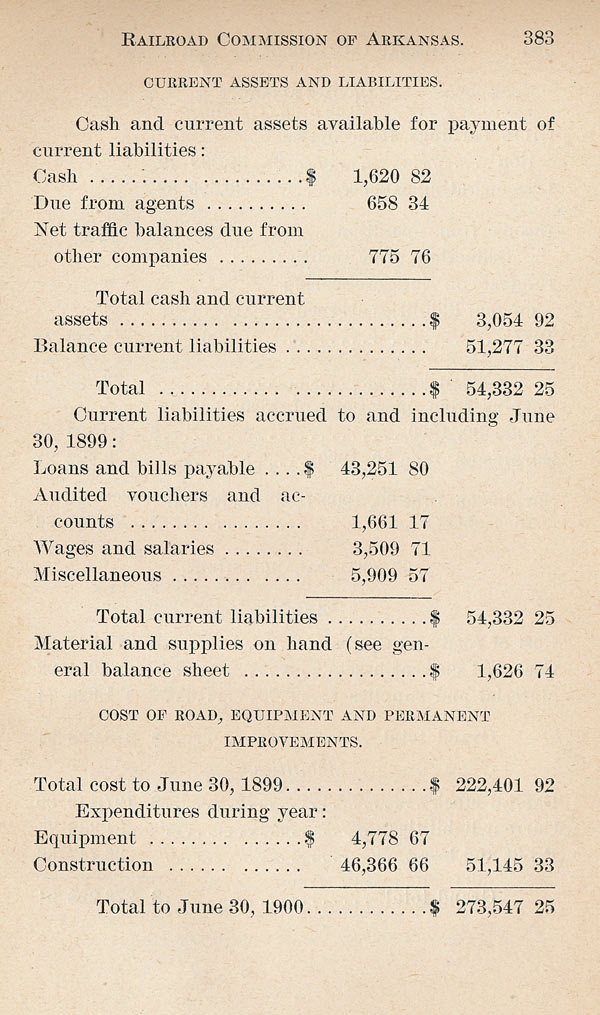

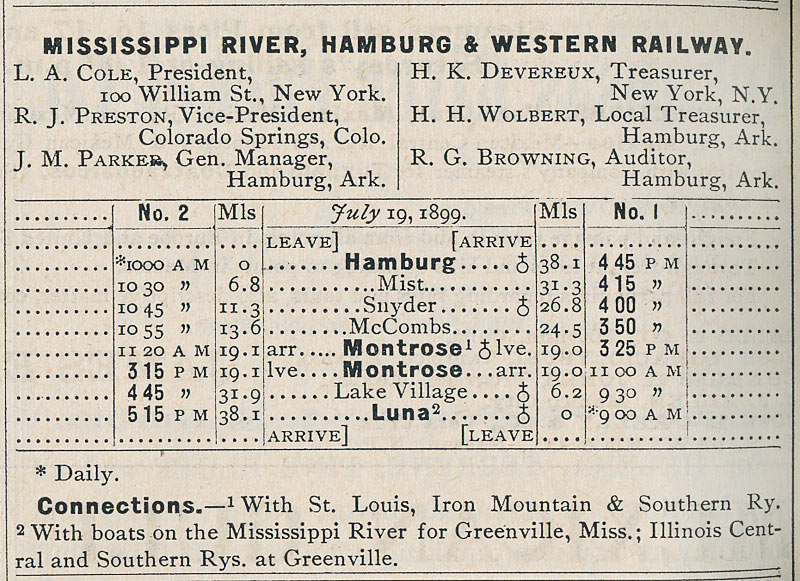
Timetable effective July 19, 1899, appearing in September 1899 issue of the Official Guide of the Railways.
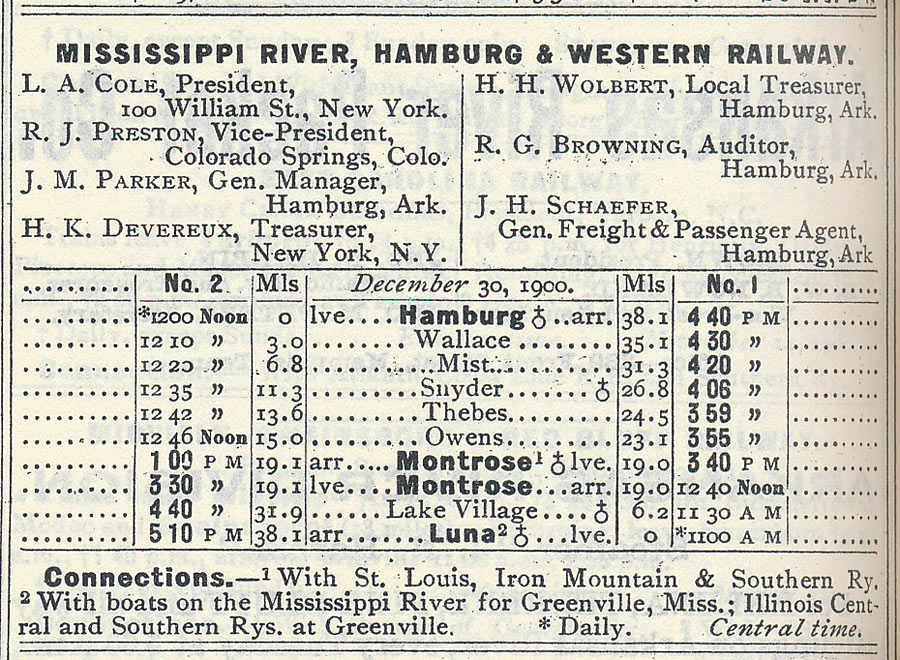
Timetable effective December 30, 1900, appearing in 1901 issues of the Official Guide. In these earlier timetables, Luna Landing was given greater prominence than Lake Village. The Iron Mountain (Memphis, Helena & Louisiana) line between Halley and the Louisiana border was not placed in service until July 1903. Until that line was opened, the river transfer at Luna was of considerably greater importance than the town of Lake Village.
The Iron Mountain acquired all capital stock of MRH&W in 1901, and thereafter operated the property as a subsidiary corporation until formally purchasing it by deed dated September 1, 1909, executed and acknowledged February 2, 1910. After the conveyance of its property to the Iron Mountain, the corporate organization of the Mississippi River, Hamburg & Western Railway was no longer maintained and ceased to exist.
According to the Missouri Pacific-St. Louis, Iron Mountain & Southern corporate history prepared in 1915, the MRH&W was completed as follows:
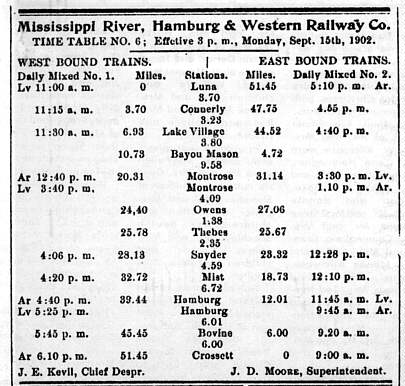


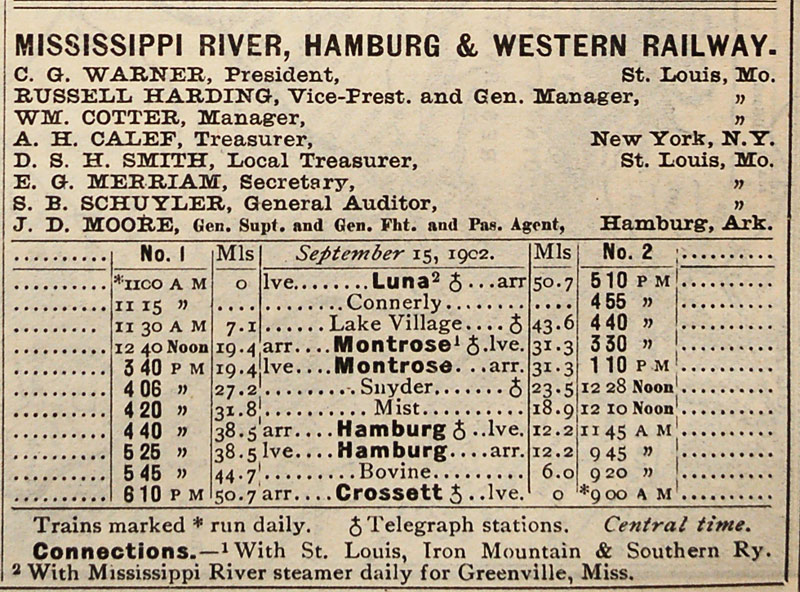

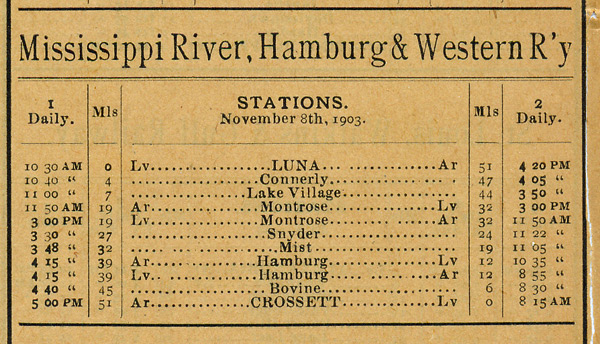
MRH&W entry appearing in the February 1, 1906 system (Form 5) timetable. Note that the MRH&W timetable itself had not been updated since November 1903.
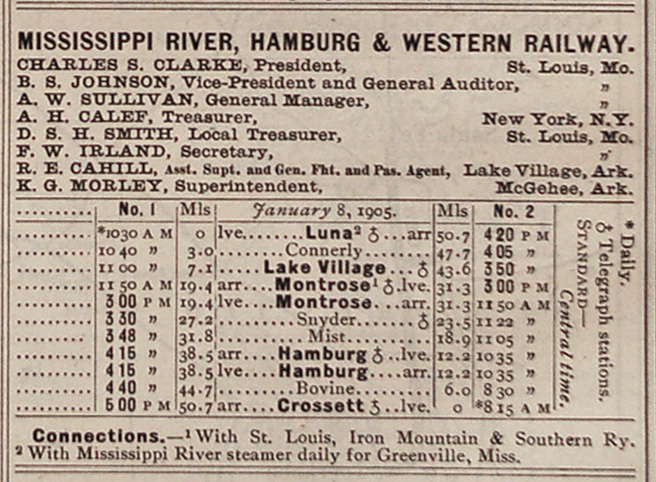
MRH&W entry appearing in the December 1905 Official Guide of the Railways.
A series of employee timetables from 1903-1909 have been identified, showing the MRH&W as a separate subsidiary. It is presumed that the MRH&W trackage was merged into the StLIM&S Valley Division after 1909. The subsequent division assignment of this trackage is unknown - it does not appear in 1924 employee timetables of the Arkansas, Louisiana or Memphis Divisions. Possibly the line was assigned to the Natchez Division, or possibly it kept a separate timetable, but both of these scenarios seem unlikely.
Known employee timetable dates below are provided by the National Association of Timetable Collectors. Please consider joining this group if you have an interest in timetables or timetable research. This is only a partial list, and the exact transition to the StLIM&S Valley Division remains to be determined.
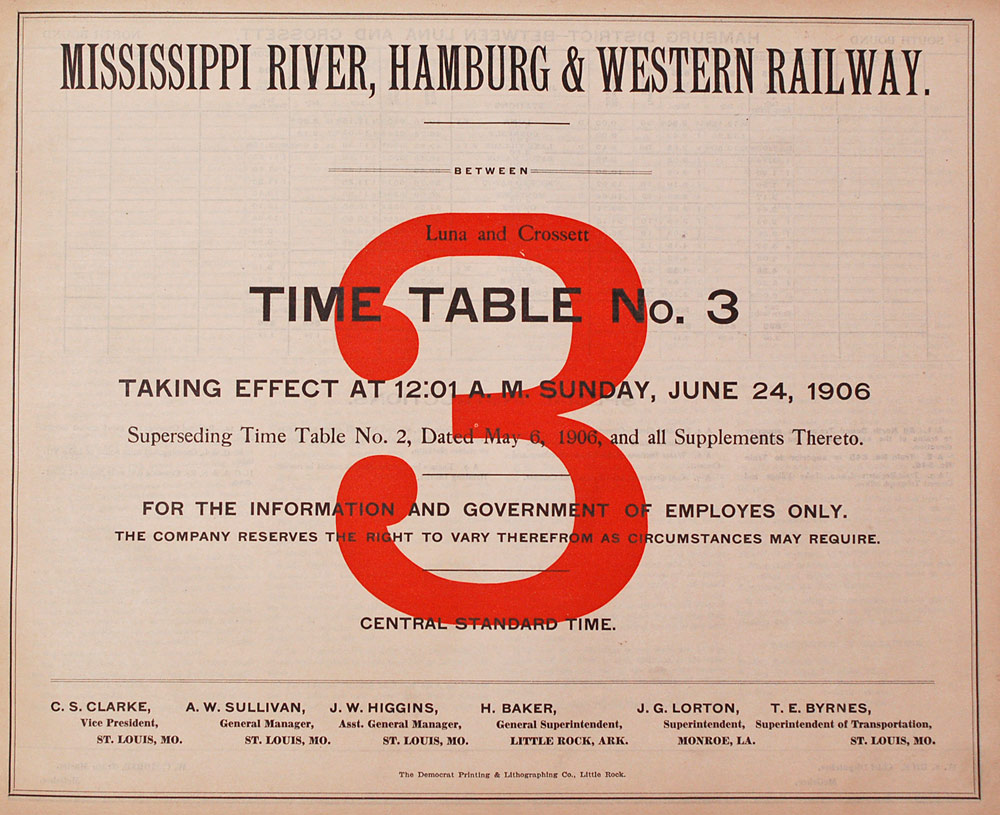
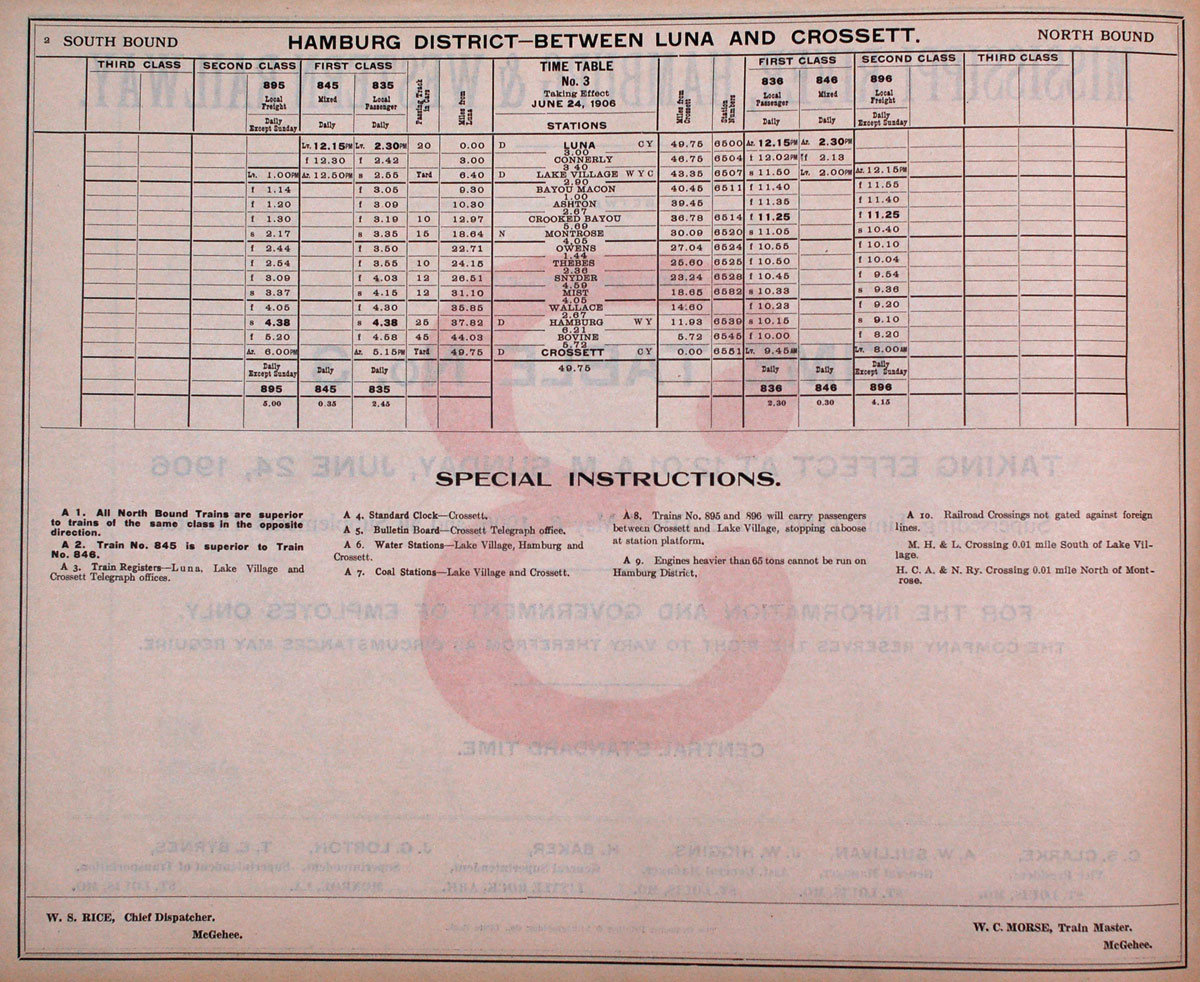
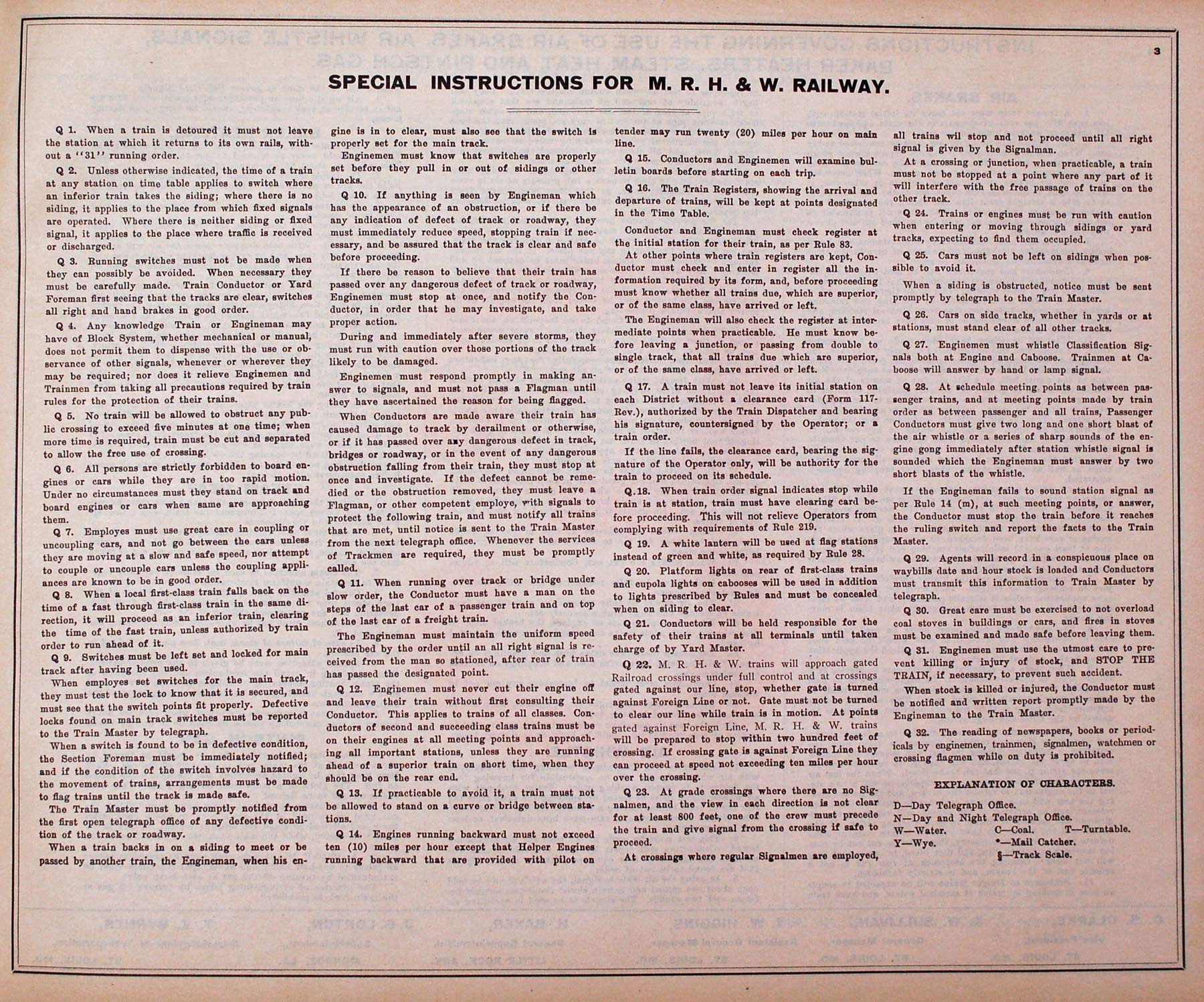

In this 1906 schedule, note that the eastbound passenger train, upon arrival at Luna, made a round trip as a mixed train between Luna and Lake Village, before beginning its westbound return trip from Luna to Crossett. The local freight train also originated out of Crossett.
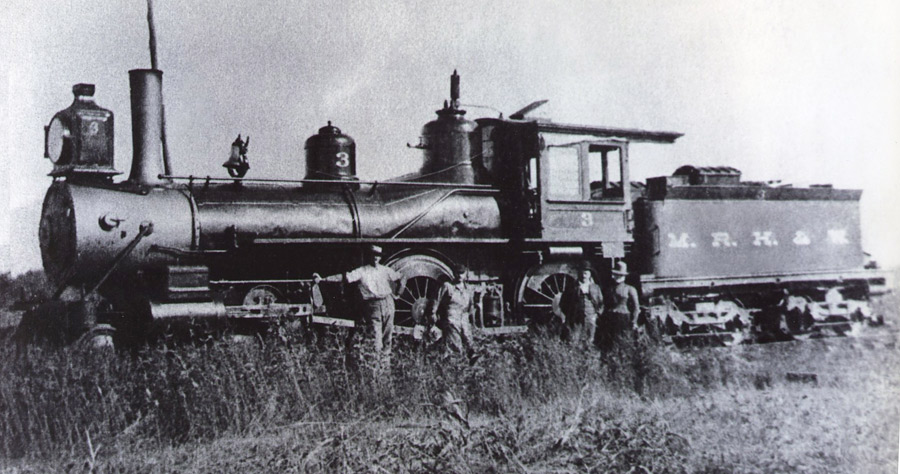
According to Missouri Pacific roster information, the following MRH&W locomotives were renumbered into the MP roster.
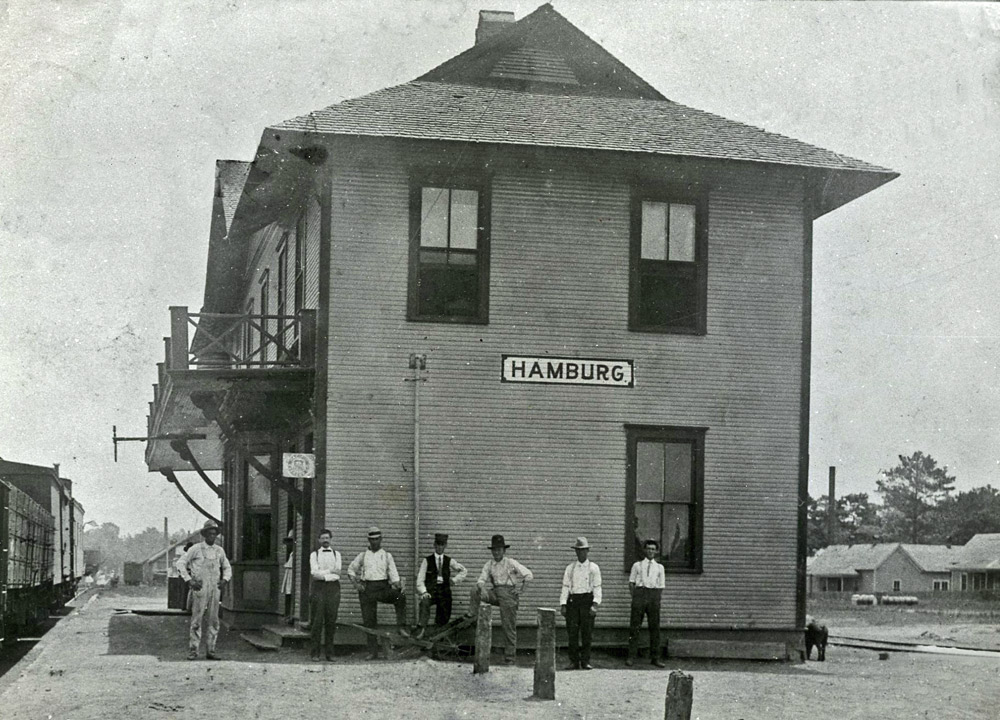
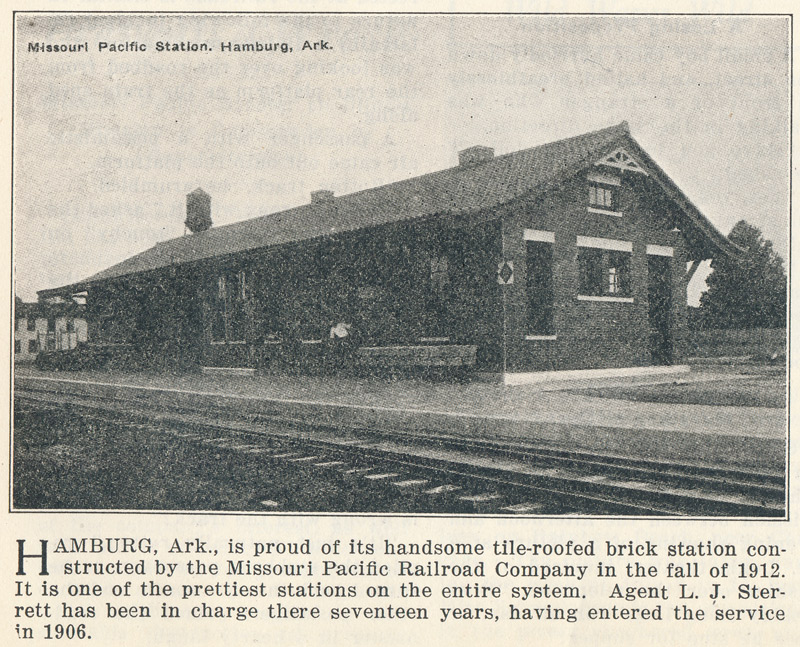
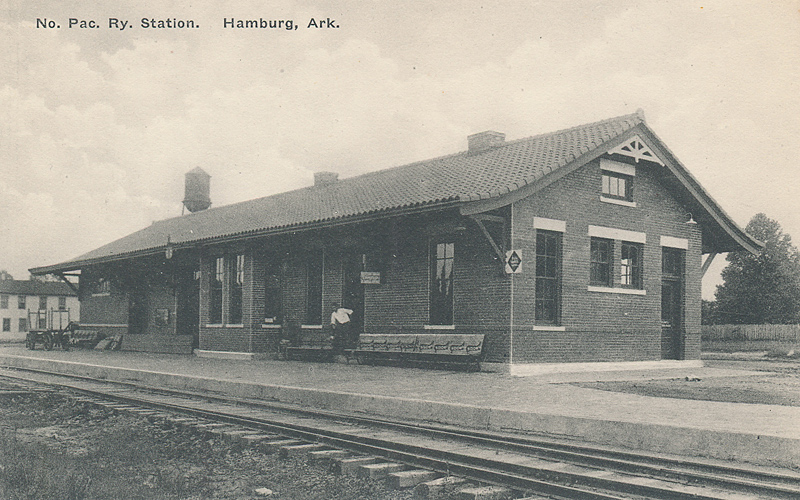
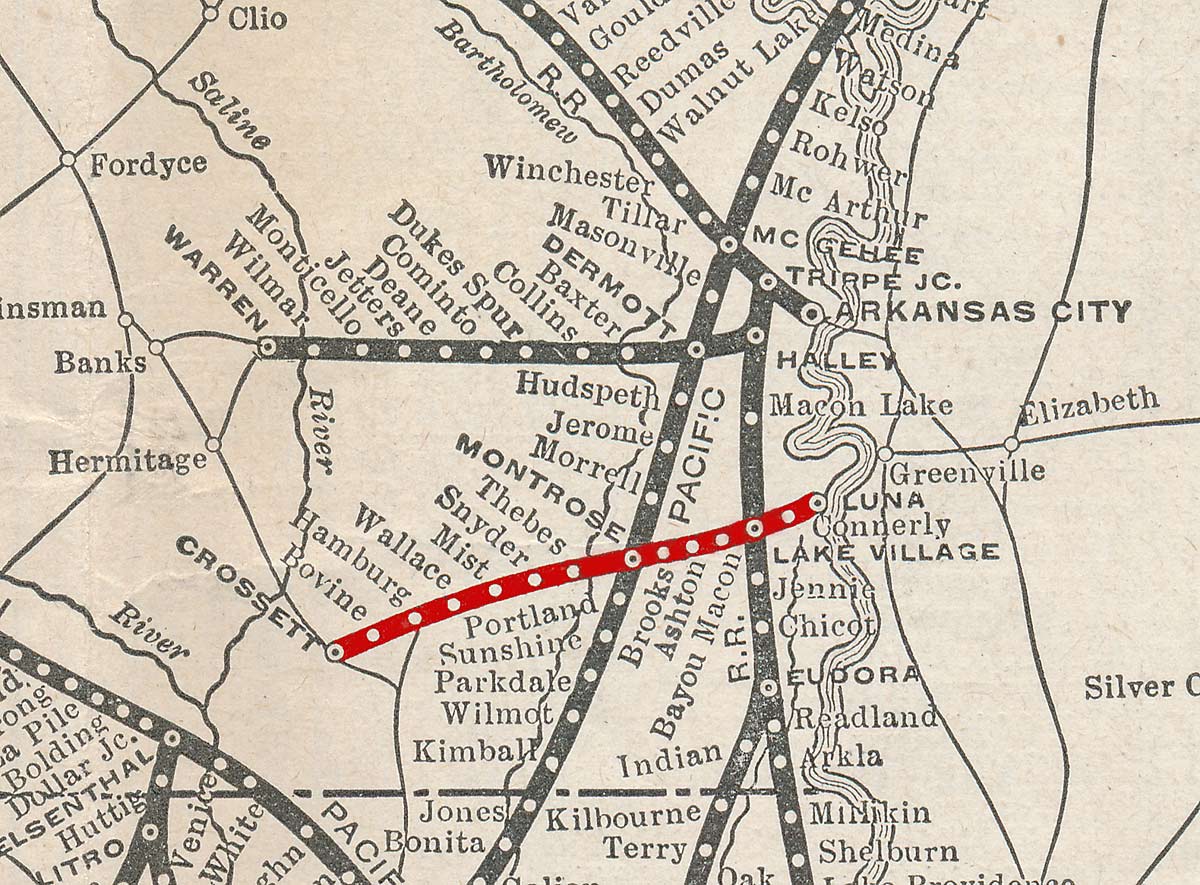
1924 map showing MRH&W trackage as part of Missouri Pacific branchline network in the Arkansas delta.
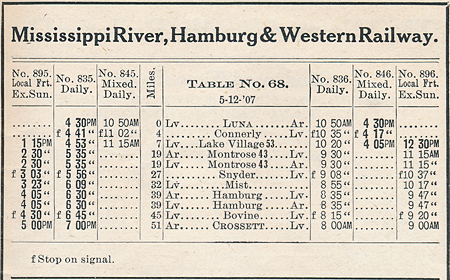

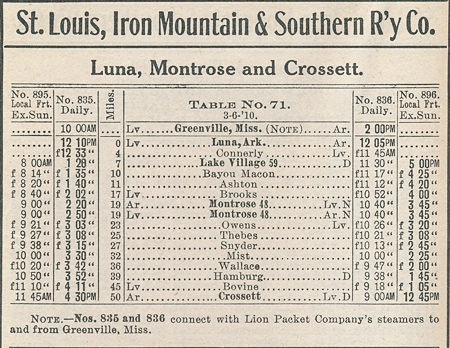
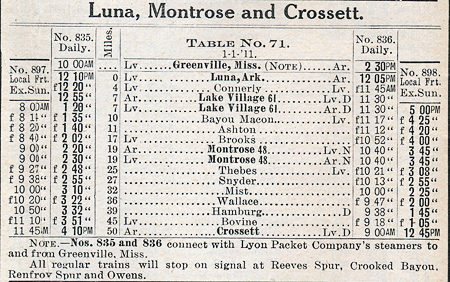
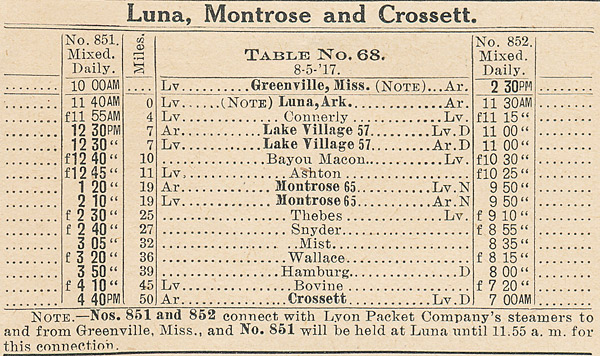
In the summer of 1917, the separate Crossett to Lake Village local freight and Crossett to Luna passenger schedules were consolidated into a daily mixed train, with a provision to hold train 851 for up to 15 minutes at Luna for the Lyon Packet Company steamer from Greenville. In October 1917, times were modified to reduce the need to hold for the steamer at Luna, and Sunday service to Luna was discontinued, probably as a consequence of reduced steamer connecting service. Service was provided to Luna Monday through Saturday, with service only as far east as Lake Village on Sunday.
The interchange arrangement between railroad and packet boat at Luna remains a mystery. The nearest actual car ferry operation was at Helena, operated by the Y&MV to Trotters Point, Mississippi and connecting with the Y&MV mainline at Lula. In prior years, a ferry operation from Arkansas City to Huntingdon, MS had been jointly operated by the Iron Mountain and the Louisville, New Orleans & Texas (a Y&MV subsidiary), but this operation had been discontinued about five years before the opening of the MRH&W. The earliest timetables show Luna as being a telegraph office, but the actual track layout to allow transfer of passengers and freight is uncertain. By the date of the 1928 employee timetable (below), Luna had only a wye and a six car siding.
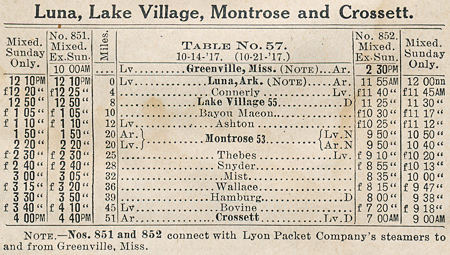
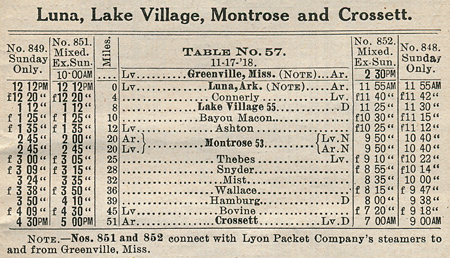
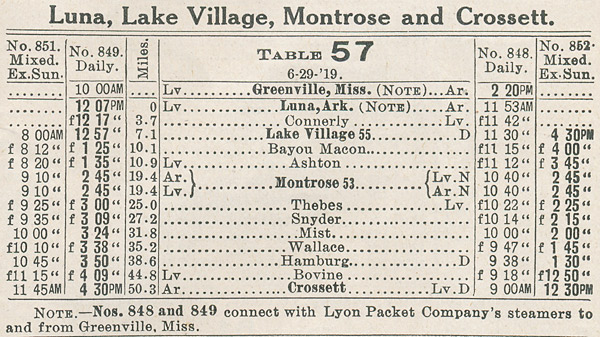
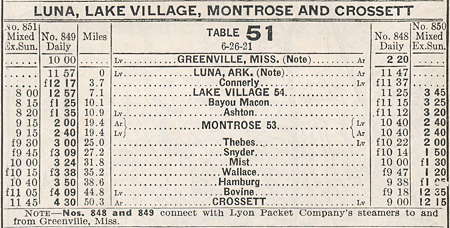
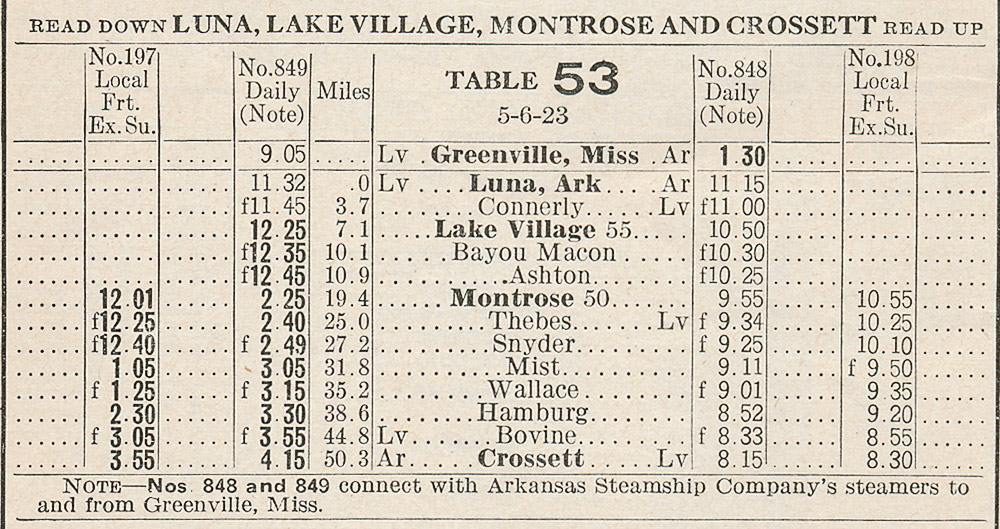
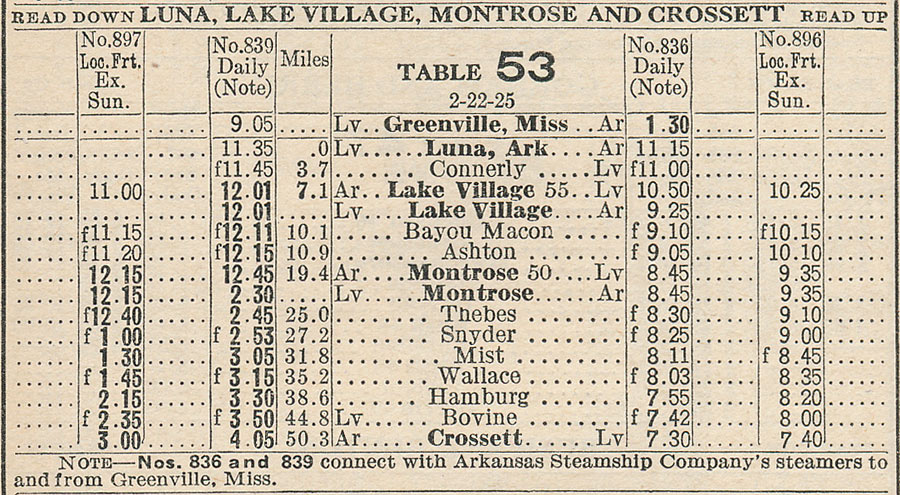
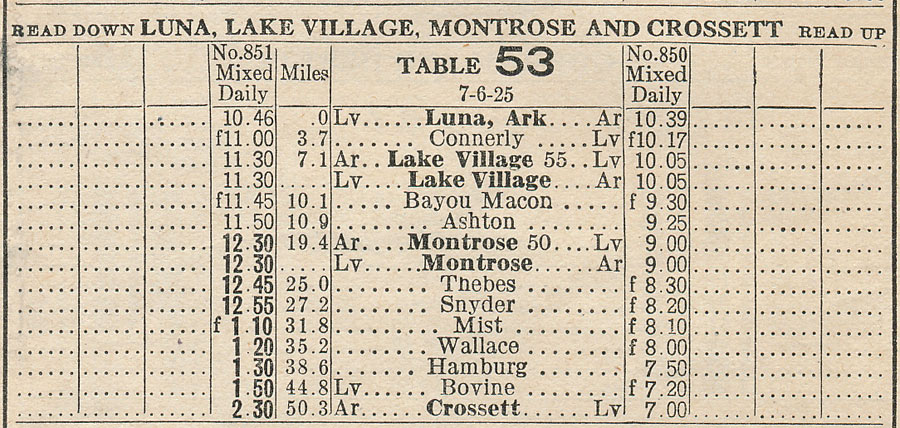
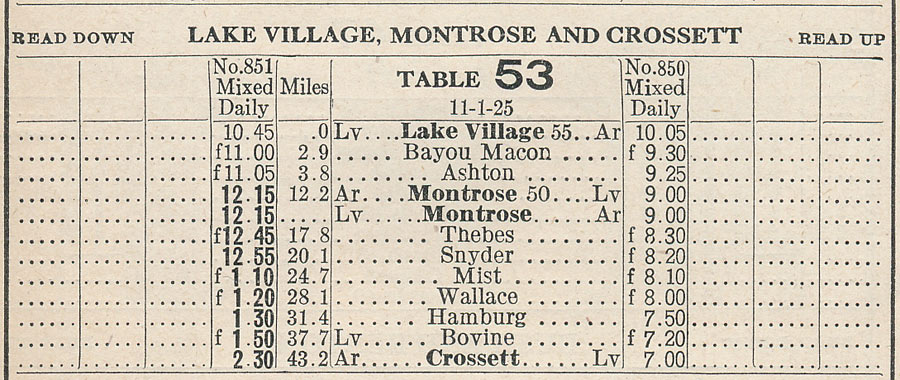
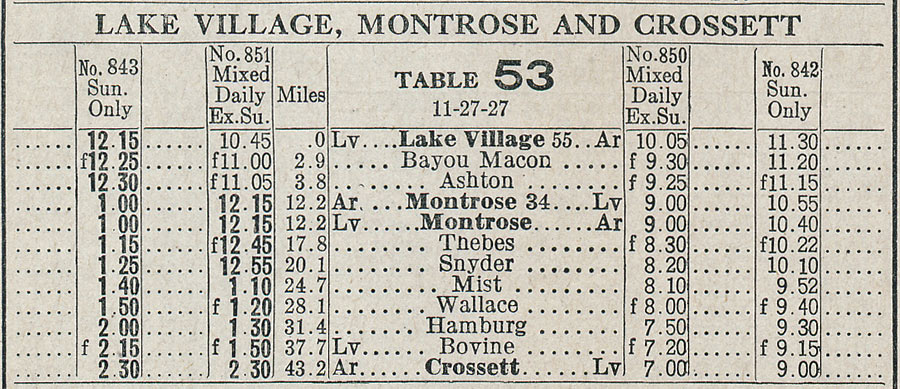
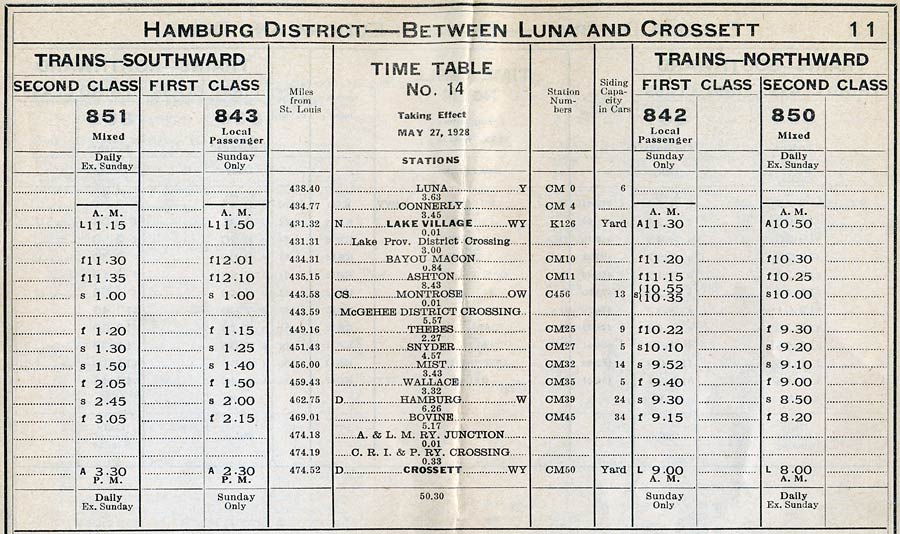
The June 7, 1925 Missouri Pacific public timetable shows a passenger train between Luna Landing and Crossett. The next timetable, July 26, 1925, shows mixed train service only between these points. The effective date on the mixed train timetable is July 6, 1925, so it is presumed that passenger service ended on July 5, 1925. The next public timetable, November 1, 1925, shows the mixed train operating only between Lake Village and Crossett, with only unscheduled freight service between Lake Village and Luna. The mixed train service was initially daily, but starting with the March 1927 public timetable, shows one mixed daily except Sunday and a second mixed Sunday only, on a slightly faster schedule. By June 1927, the Sunday only service was shown as a passenger train rather than a mixed train, and this service lasted until the June 1929 timetable, when servic reverted back to a daily except Sunday mixed train. A note advised that additional service was available between Lake Village and Crossett via Missouri Pacific Transportation Company.
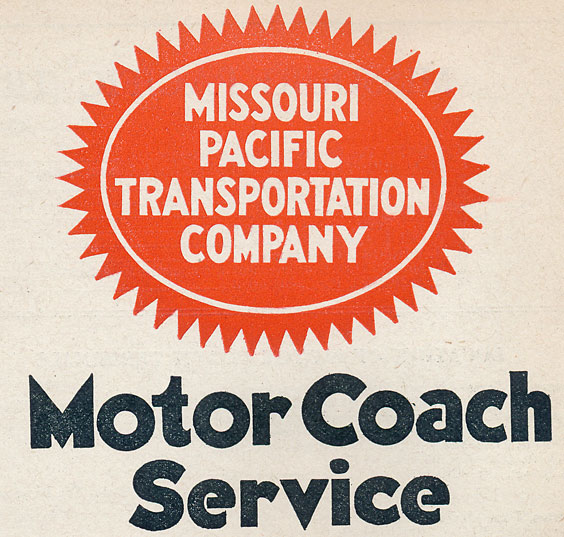
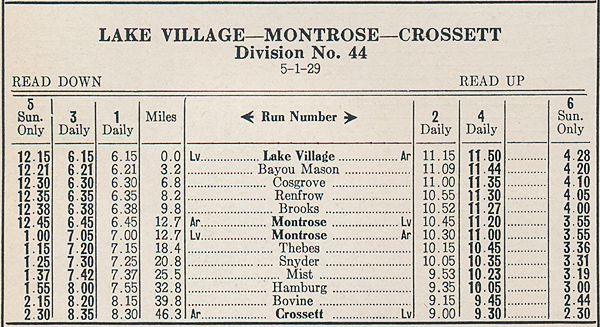
The MRH&W was abandoned in segments, with the section east from Lake Village to Luna Landing being the first to go. Logs and lumber were the predominant commodoties carried, other than one-time gravel shipments for highway construction, and even these shipments had dwindled to almost nothing. Making a bleak outlook even worse, this segment was flooded to a depth of 12 feet during the floods of 1927, resulting in heavily damaged track and bridges washed away. Because freight traffic had already declined to marginal levels, the track was never restored after the 1927 flood. An abandonment petition was filed on January 4, 1929, no objections were offered by local residents, and Interstate Commerce Commission Finance Docket 7351 authorized Missouri Pacific to dismantle this trackage.
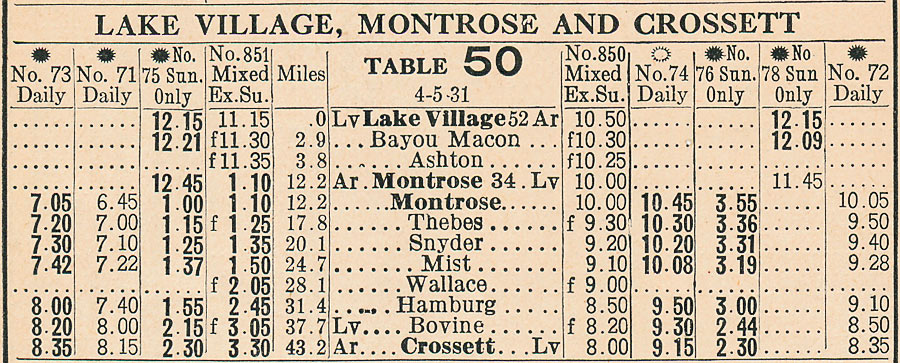
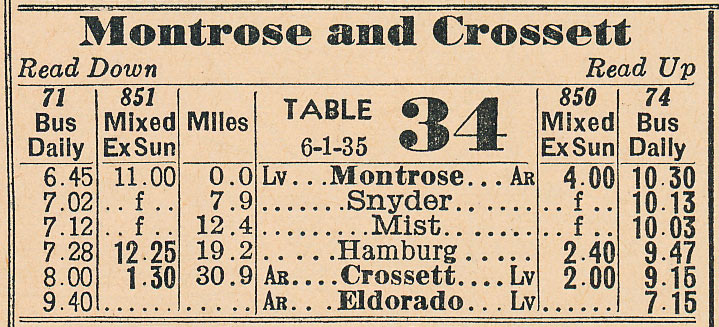
Daily except Sunday mixed train service continued between Lake Village and Crossett, and several Missouri Pacific bus schedules offered passenger service between the endpoint terminals. Freight traffic east of Montrose was negligible, and after gravel movements for a highway project were completed, an application to abandon the Montrose to Lake Village segment was filed on September 8, 1932. Once again, no objections were offered by those served by the line, and ICC approval for the abandonment was granted in Finance Docket 9617 in November 1932.
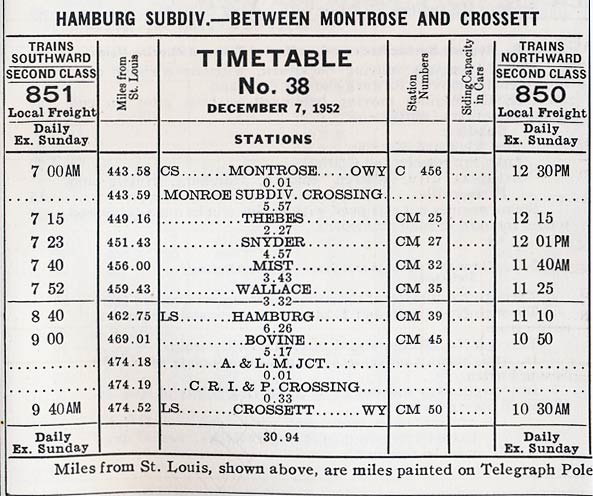
During the final years of MP service into Crossett, service on the Hamburg Subdivision was provided by a side trip of the Little Rock-Monroe local. During busy periods, service was daily, and during lighter traffic periods, service was tri-weekly. Most outbound loads from Georgia-Pacific in Crossett were routed over the AD&N to Monticello to take advantage of rate divisions. The primary interchange traffic into Crossett was pulpwood and wood chips which had originated at various mills and wood yards on the Missouri Pacific. MP also provided a steady stream of empty boxcars which were used for outbound shipments (via Monticello) from the Crossett mills.
By the mid-1970s, track conditions were being allowed to deteriorate, and it seemed inevitable that the line would eventually be abandoned. The Hamburg Subdivision last appeared in system timetable 16; regular service had apparently ended by the time system timetable 17 was issued on June 28, 1981.
